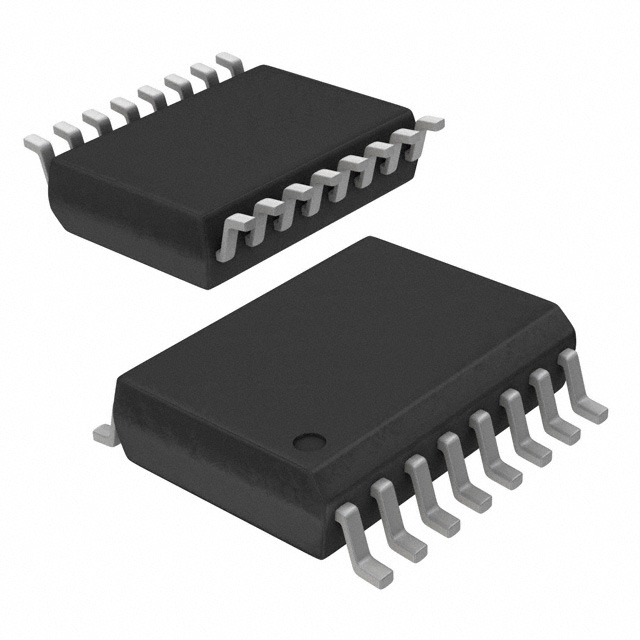MAX189ACWE+T
Product Overview
- Category: Integrated Circuit (IC)
- Use: Analog-to-Digital Converter (ADC)
- Characteristics: High-resolution, low-power consumption
- Package: 16-pin SOIC (Small Outline Integrated Circuit)
- Essence: Converts analog signals into digital data
- Packaging/Quantity: Tape and reel, 2500 units per reel
Specifications
- Resolution: 12 bits
- Sampling Rate: 100 kilosamples per second (ksps)
- Input Voltage Range: 0 to 5 volts
- Power Supply: 2.7 to 5.25 volts
- Operating Temperature Range: -40°C to +85°C
- Conversion Time: 10 microseconds (µs)
- Reference Voltage: Internal or external selectable
Detailed Pin Configuration
- VDD: Power supply voltage
- REF: Reference voltage input
- AGND: Analog ground
- VIN: Analog input voltage
- VREFOUT: Reference voltage output
- CLK: Clock input
- CS: Chip select input
- DOUT: Digital output
- DGND: Digital ground
- DIN: Digital input
- SCLK: Serial clock input
- SDI: Serial data input
- SDO: Serial data output
- PD: Power-down control
- VDD: Power supply voltage
- VSS: Ground
Functional Features
- High-resolution ADC with 12-bit resolution
- Low-power consumption for energy-efficient applications
- Selectable internal or external reference voltage
- Serial interface for easy integration with microcontrollers
- Power-down mode for reduced power consumption during idle periods
Advantages and Disadvantages
Advantages: - High resolution allows for accurate conversion of analog signals - Low-power consumption extends battery life in portable devices - Serial interface simplifies integration with microcontrollers
Disadvantages: - Limited input voltage range of 0 to 5 volts - Conversion time of 10 µs may not be suitable for high-speed applications
Working Principles
The MAX189ACWE+T is an analog-to-digital converter that converts continuous analog signals into discrete digital data. It achieves this by sampling the analog input voltage and converting it into a binary representation using a 12-bit resolution. The conversion process is controlled by an internal clock signal, and the resulting digital data is output through a serial interface.
Detailed Application Field Plans
- Industrial Automation: The MAX189ACWE+T can be used in industrial automation systems to convert analog sensor readings into digital data for further processing and control.
- Medical Devices: This ADC can be employed in medical devices such as patient monitoring systems, where accurate conversion of physiological signals is crucial.
- Data Acquisition Systems: The high-resolution and low-power characteristics make the MAX189ACWE+T suitable for data acquisition systems that require precise measurement of analog signals.
Detailed and Complete Alternative Models
- MAX11100: 16-bit ADC with similar features but higher resolution.
- MCP3208: 12-bit ADC with SPI interface and wider input voltage range.
- ADS1015: 12-bit ADC with I2C interface and programmable gain amplification.
(Note: The above alternative models are just examples and not an exhaustive list.)
This concludes the encyclopedia entry for MAX189ACWE+T, providing an overview of its product details, specifications, pin configuration, functional features, advantages and disadvantages, working principles, application field plans, and alternative models.
Lista 10 Vanliga frågor och svar relaterade till tillämpningen av MAX189ACWE+T i tekniska lösningar
Sure! Here are 10 common questions and answers related to the application of MAX189ACWE+T in technical solutions:
1. What is the MAX189ACWE+T? The MAX189ACWE+T is a high-precision, low-power, 12-bit analog-to-digital converter (ADC) with an integrated reference and temperature sensor.
2. What is the operating voltage range of MAX189ACWE+T? The operating voltage range of MAX189ACWE+T is from 2.7V to 5.25V.
3. What is the maximum sampling rate of MAX189ACWE+T? The maximum sampling rate of MAX189ACWE+T is 200 kilosamples per second (ksps).
4. Can I use MAX189ACWE+T for temperature sensing applications? Yes, MAX189ACWE+T has an integrated temperature sensor that can be used for temperature sensing applications.
5. Does MAX189ACWE+T support multiple input channels? Yes, MAX189ACWE+T supports up to 8 single-ended or 4 differential input channels.
6. What is the resolution of MAX189ACWE+T? MAX189ACWE+T has a resolution of 12 bits, which means it can provide 4096 discrete voltage levels.
7. Is MAX189ACWE+T suitable for battery-powered applications? Yes, MAX189ACWE+T is designed to operate at low power and is suitable for battery-powered applications.
8. Can I interface MAX189ACWE+T with microcontrollers or processors? Yes, MAX189ACWE+T has a serial interface (SPI) that allows easy interfacing with microcontrollers or processors.
9. What is the typical accuracy of MAX189ACWE+T? The typical accuracy of MAX189ACWE+T is ±1 LSB (Least Significant Bit) for the ADC and ±2°C for the temperature sensor.
10. Are there any evaluation boards or development kits available for MAX189ACWE+T? Yes, Maxim Integrated provides evaluation boards and development kits for MAX189ACWE+T to facilitate its integration into technical solutions.
Please note that these answers are based on general information about MAX189ACWE+T and may vary depending on specific application requirements. It is always recommended to refer to the datasheet and application notes provided by the manufacturer for detailed information.


